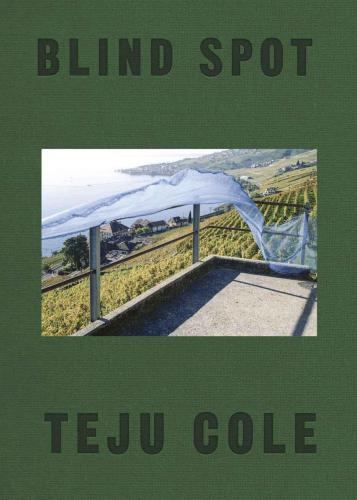
Blind Spot
کتاب های مرتبط
- اطلاعات
- نقد و بررسی
- دیدگاه کاربران
نقد و بررسی

Starred review from May 15, 2017
In this collection of photos, cultural critic Cole (Known and Strange Things) explores the construct and limitations of human perception using snapshots from his travels paired with his written interpretations. He transports readers around the world to the Congo, Germany, Lebanon, Libya, New Zealand, Nigeria, and elsewhere, turning his lens on quotidian and intimate scenes that are at once familiar and foreign. A photo of hotel-room draperies inspires in him thoughts of Albrecht Dürer and the relationship of the human and divine: “In the crumbles, pleats, gathers, creases, falls, twists, and billows of cloth is a regular irregularity that is like the surface of water, like channels of air, like God made visible.” Later, an image of tables draped in white plastic table cloths calls to mind the hotel-room drapes, and then thoughts of Dürer again. Each turn of the page brings a new pairing of written and visual record, and with it an impressionistic branch to what Cole refers to as “a tangled tree of meanings.” In the foreword, novelist Siri Hustvedt aptly describes the work as a study of “a person’s embodied consciousness in relation to the visual word.” This ambitious study deserves a spot on the shelf next to Roland Barthes’s Camera Lucida and Susan Sontag’s On Photography. 150 color photos.

April 15, 2017
Memoir meets museum catalog in this engagingly meandering, genre-bending collection.Cole's debut novel, Open City (2011), is written nearly entirely as the inner monologue of his protagonist, a graduate student walking around New York. In less capable hands, this would be insufferable, but Cole (Known and Strange Things, 2016, etc.) is a master of the quiet, often nonsensical workings of the mind. Here, images take center stage: one per every two pages, with short accompanying text, like the notes at a gallery show (which they are--the images were originally on display in a solo exhibition in Milan). Cole made the pictures over a three-year period as he traveled the globe from Seoul to the Swiss Alps to London to Lagos and back to Brooklyn, where he makes his home. But this is hardly a travelogue; while the pictures are often gorgeous, they are not iconic or grand. Rather, Cole focuses on small things--e.g., the shadows of an outdoor staircase adjacent to the sweeping mountain view at an Alpine summit, tables being set up for an event in Rome, a partially open garage door in Ubud, Indonesia. Tarps and drapery are common themes--they cover musical instruments in Lagos, a brick wall in Berlin, and the windows of countless hotel rooms. War and violence also loom prominently, though the images are uniformly quiet and profoundly peaceful. Accompanying a photo of a nondescript conference room in Seoul, Cole writes about missile negotiations; in Zurich, he remembers "all the places and bodies that had been blown apart by the hundreds of millions of dollars of annual Swiss arms sales." The author is present in some of the text: waiting for a haircut or moving into a new house, a constant reminder that we are seeing the world through a particular set of eyes. As Siri Hustvedt asks in the preface, "what is seeing? What is inside the looking person and what is outside him? How do we parse what we see?" A strange, cerebral, and very beautiful journey.
COPYRIGHT(2017) Kirkus Reviews, ALL RIGHTS RESERVED.

October 1, 2017
Readers may be most familiar with Cole as a novelist and essayist (Every Day Is for the Thief; Known and Strange Things), but he is also an accomplished photographer and critic, contributing to the "On Photography" column for the New York Times Magazine. Many photographers have experimented with combining text and image, but this title brings them together in ways unusually sophisticated, expanding the possibilities of the photo caption. A travelog of sorts, this book presents images taken during the artist's journeys around the world. Cole's pictures, however, lack the superficial gloss associated with much travel photography--many are, in fact, rather banal takes of hotel rooms or unremarkable streets. The outwardly nondescript images serve as triggers for the photographer's thoughts and feelings about place, as he investigates what one can make visible through the medium, and how photos might express facts beyond the obvious surface. These image/text combinations merge interior monolog with an outward-looking gaze. VERDICT Highly recommended as a project expanding our sense of what it means to create and look at photographs.
Copyright 2017 Library Journal, LLC Used with permission.

June 1, 2017
Cole is an award-winning novelist (Open City, 2011), essayist (Known and Strange Things, 2016), art historian, photographer, and world traveler. Deeply attuned to the profundity of seeing, of what we perceive and what we don't, Cole nearly lost his vision in one eye, an experience that shaped this exquisite pairing of images and lyric essay, incisively introduced by novelist and essayist Siri Hustvedt (A Woman Looking at Men Looking at Women, 2016). At first look, Cole's photographs from Brooklyn, Beirut, Bali, Lagos, Nuremberg, Selma, and beyond seem strangely humble: an RV parked behind a hedge, filmy white curtains, construction sites. But image-by-image, his acute sensitivity to shadows and reflections comes into evocative focus; so, too, his perception of translucency and opacity, multiple layers and confusions of scale. Cole's strongly patterned compositions capture the expressiveness of chain-link fences, crosses, windows, furniture, signs, and puddles. His accompanying narrative is a mosaic of memories, anecdotes, myths, Bible stories, and grim historical facts. Cole's deeply affecting work juxtaposes tragedy with hidden-in-plain-sight beauty as he embraces poetic possibility in every scene and moment.(Reprinted with permission of Booklist, copyright 2017, American Library Association.)

























دیدگاه کاربران